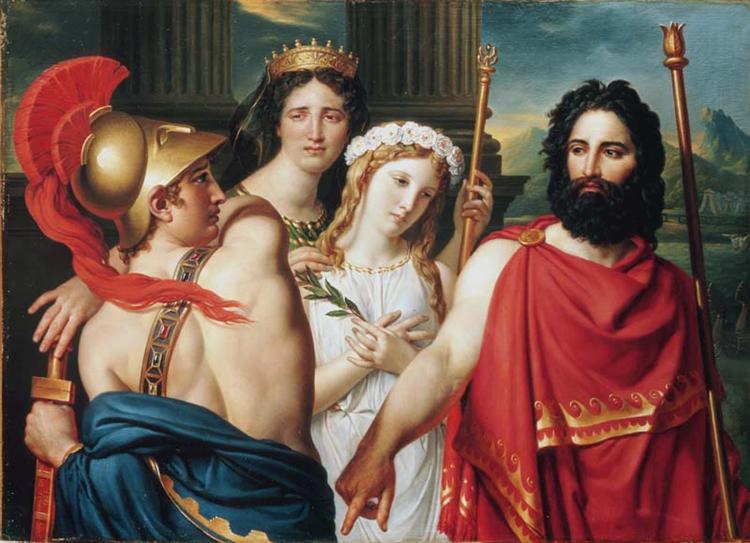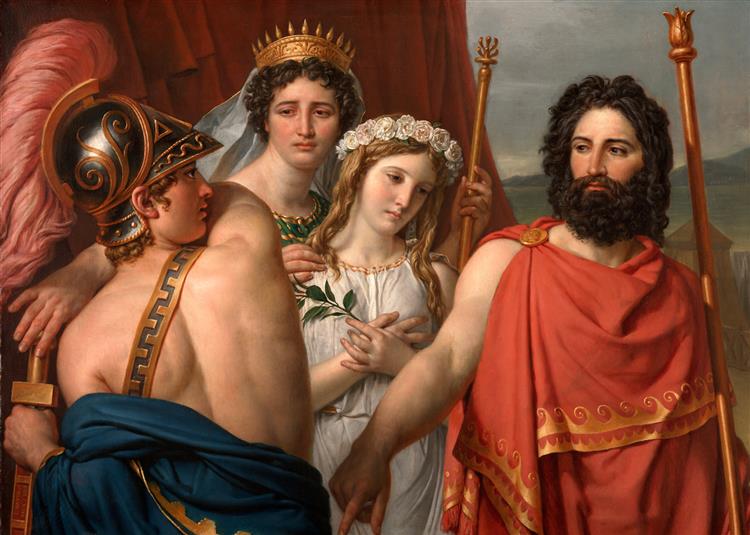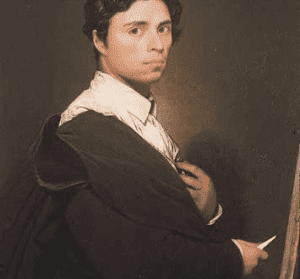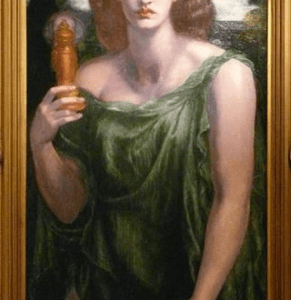In the world of art, few painters could capture raw, dramatic tension like Jacques-Louis David, the father of Neoclassicism. Painted in 1819 during his final years, The Anger of Achilles is a masterclass in historical and mythological storytelling. This powerful work freezes a moment of ultimate betrayal, showcasing the explosive fury of a legendary hero and the heartbreaking grief of a royal family caught in the cruel whims of the gods.

Now a treasure of the Kimbell Art Museum in Fort Worth, Texas, this painting is one of the last great history paintings from a revolutionary artist, boiling down an epic Greek tragedy into a single, unforgettable scene.
The Story: The Deception at Aulis 
To feel the full impact of the painting, you must first know the myth. The scene comes from the prelude to the Trojan War. The Greek fleet, led by King Agamemnon, is stranded at the port of Aulis, unable to sail for Troy due to a lack of wind. The goddess Artemis, whom Agamemnon has offended, demands an unthinkable price for favourable winds: the sacrifice of the king’s own daughter, Iphigenia.
To lure her to the camp, Agamemnon concocts a terrible lie. He promises her hand in marriage to Greece’s greatest warrior, the demigod Achilles. David’s painting captures the precise moment the deception unravels. Agamemnon has just revealed his true, horrifying intention to Achilles. Iphigenia is not here to be a bride but a sacrifice. We are witnessing the spark that ignites the hero’s legendary rage.
Neoclassical Drama: An Artistic Breakdown 
David constructs the scene like a theatrical stage, using every element to heighten the emotional drama and moral clarity, hallmarks of the Neoclassical style.
Composition and Tension
The figures are arranged in a shallow, frieze-like space that pushes the action directly toward the viewer. The core tension is in the explosive, diagonal energy of Achilles as he lunges forward, his hand grabbing the hilt of his sword. This movement is contrasted by the rigid, columnar stance of Agamemnon, who raises a hand not to stop Achilles, but in a gesture of grim, unhappy resolve. He avoids Achilles’ furious gaze, unable to face the consequences of his betrayal.
The Characters’ Emotions
Achilles: He is the focal point of the painting. His body, rendered with anatomical precision, is coiled with righteous fury. The brilliant red cloth swirling around him seems to symbolize his boiling anger. He is the embodiment of betrayed honour.
Agamemnon: Dressed in royal regalia, he represents the terrible conflict between duty to the state and duty to family. His averted eyes and weary expression show a man trapped by fate, forced to make a monstrous choice.
Clytemnestra and Iphigenia: To the right, Agamemnon’s wife, Clytemnestra, pulls her daughter close. Her face is a mask of pure anguish and horror as she realizes her husband’s plan. Iphigenia, in contrast, appears calm and innocent, a lamb unaware of her imminent slaughter, which only amplifies the tragedy.
Colour and Light
David uses a clear, hard light that illuminates every detail with stark clarity—there are no soft shadows to hide the raw emotion. The bold, primary colours of the characters’ robes—Achilles’ red, Agamemnon’s blue, and Clytemnestra’s gold—make each figure distinct and intensify the dramatic impact.
A Master’s Final Act
It’s crucial to note that David painted The Anger of Achilles while living in exile in Brussels, following the defeat of his patron, Napoleon Bonaparte. This work proves that even in his final years, his skill and dramatic vision were undiminished. While the 1819 Kimbell version is David’s definitive work, a later copy from 1825 exists, which was reportedly finished by his pupil, Michel Ghislain Stapleaux, under the master’s direction as his health failed.
Key Facts at a Glance
Artist: Jacques-Louis David (1748-1825)
Title: The Anger of Achilles
Date: 1819
Medium: Oil on canvas
Style: Neoclassicism
Genre: Mythological painting
Dimensions: 105.3 x 145 cm (41 7/16 x 57 1/16 in.)
Location: Kimbell Art Museum, Fort Worth, Texas, USA
Seeing the Masterpiece in Fort Worth
The Anger of Achilles is a cornerstone of the Kimbell Art Museum’s European collection and a must-see for any art lover. Its presence in Fort Worth offers a rare opportunity to study a late-career masterpiece by one of history’s most influential artists. Before planning your trip, be sure to visit the Kimbell’s official website for current hours and exhibition details.
This painting is more than just an illustration of a myth; it’s a timeless exploration of honour, betrayal, and the terrible sacrifices demanded by power and destiny.
Recommend0 recommendationsPublished in Art History, Artworks









Responses